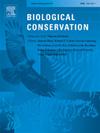Wetland fish in peril: A synergy between habitat loss and biological invasions drives the extinction of neglected native fauna
IF 4.9
1区 环境科学与生态学
Q1 BIODIVERSITY CONSERVATION
引用次数: 0
Abstract
European wetlands, crucial freshwater ecosystems, face multiple anthropogenic threats. For native wetland fish species (NWFS), habitat degradation and the spread of invasive non-native species (INS) are the most important, and place NWFS at increasing extinction risks. This perspective study examines the impact of these combined threats on the NWFS. Four characteristic species with the largest distribution area in the European Union were evaluated, which share the habitat requirements and susceptibility to these impacts – crucian carp (Carassius carassius), European weatherfish (Misgurnus fossilis), sunbleak (Leucaspius delineatus) and mudminnow (Umbra krameri). Here, we investigated how the interplay of habitat loss and biological invasions impacts the population and conservation status of these species. This study seeks to stimulate more conservation-oriented research leading to cross-border cooperation on conservation status monitoring and repopulation programmes. Improved knowledge of impacts and mechanisms of habitat loss and interspecific interactions with INS is vital for safeguarding the remaining populations of NWFS, allowing for repopulation measures with genetically suitable individuals in severely impacted areas.

求助全文
约1分钟内获得全文
求助全文
来源期刊

Biological Conservation
环境科学-环境科学
CiteScore
10.20
自引率
3.40%
发文量
295
审稿时长
61 days
期刊介绍:
Biological Conservation is an international leading journal in the discipline of conservation biology. The journal publishes articles spanning a diverse range of fields that contribute to the biological, sociological, and economic dimensions of conservation and natural resource management. The primary aim of Biological Conservation is the publication of high-quality papers that advance the science and practice of conservation, or which demonstrate the application of conservation principles for natural resource management and policy. Therefore it will be of interest to a broad international readership.
 求助内容:
求助内容: 应助结果提醒方式:
应助结果提醒方式:


